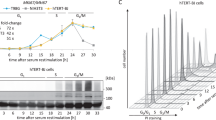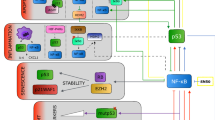Abstract
The expression of the human Ki-67 protein, which is strictly associated with cell proliferation, is regulated by a variety of cellular mediators. In this study, we studied the effects of p53 on Ki-67 promoter in HeLa cells using luciferase reporter assay. The results showed that: (1) p53 inhibited Ki-67 promoter activity in a dose-dependent manner, (2) the p53-binding motifs mediated part of the transcriptional repression of Ki-67 promoter through a sequence-specific interaction with p53, (3) p53 was able to repress the Sp1-stimulated Ki-67 promoter activity, and (4) the Sp1-binding sites were responsible for the p53-mediated transcriptional repression of Ki-67 promoter. In conclusion, p53 inhibited Ki-67 promoter activity via p53- and Sp1-dependent pathways, and the interaction between p53 and Sp1 might be involved in the transcriptional regulatory mechanisms.







Similar content being viewed by others
References
Parkin DM, Pisani P, Ferlay J. Global cancer statistics. CA Cancer J Clin. 1999;49:33–64.
Isobe M, Emanuel BS, Givol D, Oren M, Croce CM. Localization of gene for human p53 tumour antigen to band 17p13. Nature. 1986;320:84–5.
Levine AJ, Momand J, Finlay CA. The p53 tumour suppressor gene. Nature. 1991;351:453–6.
Olivier M, Hussain SP, Caron de Fromentel C, Hainaut P, Harris CC. TP53 mutation spectra and load: a tool for generating hypotheses on the etiology of cancer. IARC Sci Publ. 2004;157:247–70.
Michalovitz D, Halevy O, Oren M. p53 mutations: gains or losses? J Cell Biochem. 1991;45:22–9.
Scheffenr M, Münger K, Byrne JC, Howley P. The state of the p53 and retinoblastoma genes in human cervical carcinoma cell lines. Proc Natl Acad Sci USA. 1991;88:5523–7.
Gerdes J, Lemeke H, Baisch H, Wacker HH, Schwab U, Stein H. Cell cycle analysis of a cell proliferation-associated human nuclear antigen defined by the moncelonal antibody ki67. J Immunol. 1984;133:1710–5.
Schlzen T, Gerdes J. The Ki-67 protein:from the known and the unknown. J Cell Physiol. 2000;182:311–22.
Shirendeb U, Hishikawa Y, Moriyama S, Win N, Thu MM, Mar KS, et al. Human papillomavirus infection and its possible correlation with p53 expression in cervical cancer in Japan, Mongolia, and Myanmar. Acta Histochem Cytochem. 2009;42:181–90.
Gorczyca W, Markiewski M, Kram A. Immunohistochemical analysis of bcl-2 and p53 expression in breast carcinomas: their correlation with Ki-67 growth fraction. Virchows Arch. 1995;426:229–33.
Iamaroon A, Khemaleelakul U, Pongsiriwet S, Pintong J. Co-expression of p53 and Ki67 and lack of EBV expression in oral squamous cell carcinoma. J Oral Pathol Med. 2004;33:30–6.
Georgescu CV, Săftoiu A, Georgescu CC, Ciurea R, Ciurea T. Correlations of proliferation markers, p53 expression and histological findings in colorectal carcinoma. J Gastrointestin Liver Dis. 2007;16:133–9.
Halm U, Tannapfel A, Breitung B, Breidert M, Wittekind CW, Mössner J. Apoptosis and cell proliferation in the metaplasiadysplasia-carcinoma-sequence of Barrett's esophagus. Hepatogastroenterology. 2000;47:962–6.
Krishnadath KK, Reid BJ, Wang KK. Biomarkers in Barrett esophagus. Mayo Clin Proc. 2001;76:438–46.
Lopes CV, Pereira-Lima J, Hartmann AA. p53 immunohistochemical expression in Barrett's esophagus before and after endoscopic ablation by argon plasma coagulation. Scand J Gastroenterol. 2005;40:259–63.
Tian H, Qian GW, Chen FF, Di JH, Zhang BF, Pei DS, et al. A critical role of Sp1 transcription factor in regulating the human Ki-67 gene expression. Tumor Biol. 2010;32:273–83.
Hooghe B, Hulpiau P, Roy FV, Bleser PD. ConTta: a promoter alignment analysis tool for dentification of transcription factor binding sites across species. Nucleic Acids Res. 2008;36:128–32.
Matlashewski G, Banks L, Pim D, Crawford L. Analysis of human p53 proteins and mRNA levels in normal and transformed cells. Eur J Biochem. 1986;154:665–72.
Króliczak W, Pietrzak M, Puzianowska-Kuznicka M. p53-dependent suppression of the human cacyclin gene (S100A6) the role of Sp1 and of NFκB. Acta Biochim Pol. 2008;55:559–70.
Levine AJ. p53, the cellular gatekeeper for growth and division. Cell. 1997;88:323–32.
Ko LJ, Prives C. p53: puzzle and paradigm. Genes Dev. 1996;10:1054–72.
Cuesta A, Zambrano A, Royo M, Pascual A. The tumour suppressor p53 regulates the expression of amyloid precursor protein (APP). Biochem J. 2009;418:643–50.
Shirley SH, Rundhaug JE, Tian J, Cullinan-Ammann N, Lambertz I, Conti CJ, et al. Transcriptional regulation of estrogen receptor-α by p53 in human breast cancer cells. Cancer Res. 2009;69:3404–14.
Bocangel D, Sengupta S, Mitra S, Bhakat KK. p53-Mediated down-regulation of the human DNA repair gene O6-Methylguanine-DNA Methyltransferase (MGMT) via interaction with Sp1 transcription factor. Anticancer Res. 2009;29:3741–50.
St Clair S, Giono L, Varmeh-Ziaie S, Resnick-Silverman L, Liu WJ, Padi A, et al. DNA damage-induced downregulation of Cdc25C is mediated by p53 via two independent mechanisms: one involves direct binding to the cdc25C promoter. Mol Cell. 2004;16:725–36.
Li B, Lee MY. Transcriptional regulation of the human DNA polymerase δ catalytic subunit gene POLD1 by p53 tumor suppressor and Sp1. J Biol Chem. 2001;276:29729–39.
Farmer G, Friedlander P, Colgan J, Manley JL, Prives C. Transcriptional repression by p53 involves molecular interactions distinct from those with the TATA box binding protein. Nucleic Acids Res. 1996;24:4281–8.
Glait C, Tencer L, Ravid D, Sarfstein R, Liscovitch M, Werner H. Caveolin-1 up-regulates IGF-I receptor gene transcription in breast cancer cells via Sp1- and p53-dependent pathways. Exp Cell Res. 2006;312:3899–908.
Farmer G, Colgan J, Nakatani Y, Manley JL, Prives C. Functional interaction between p53, the TATA-binding protein (TBP), and TBP-associated factors in vivo. Mol Cell Biol. 1996;16:4295–304.
Borellini F, Glazer RI. Induction of Sp1-p53 DNA-binding heterocomplexes during granulocyte/macrophage colony-stimulating factor-dependent proliferation in human erythroleukemia cell line TF-1. J Biol Chem. 1993;268:7923–8.
Torgeman A, Mor-Vaknin N, Zelin E, Ben-Aroya Z, Löchelt M, Flügel RM, et al. Sp1-p53 heterocomplex mediates activation of HTLV-I long terminal repeat by 12-O-tetradecanoylphorbol-13-acetate that is antagonized by protein kinase C. Virology. 2001;281:10–20.
Koutsodontis G, Vasilaki E, Chou WC, Papakosta P, Kardassis D. Physical and functional interactions between members of the tumour suppressor p53 and the Sp families of transcription factors: importance for the regulation of genes involved in cell-cycle arrest and apoptosis. Biochem J. 2005;389:443–55.
Acknowledgments
This project is supported by grants from the National Natural Science Foundation of China (no. 30972976, 81071854), the Science and Technology Department of Jiangsu province (no. BK2009091, BK2010177), and the Program for New Century Excellent Talents in University (NCET-08-0700). We thank Dr. Zhang YP for providing the p53 expression plasmid and Dr. Guntram Suske for Sp1 expression plasmid.
Conflicts of interest
None
Author information
Authors and Affiliations
Corresponding author
Additional information
Mei-Juan Wang and Dong-Sheng Pei contributed equally to this work.
Rights and permissions
About this article
Cite this article
Wang, MJ., Pei, DS., Qian, GW. et al. p53 regulates Ki-67 promoter activity through p53- and Sp1-dependent manner in HeLa cells. Tumor Biol. 32, 905–912 (2011). https://doi.org/10.1007/s13277-011-0191-4
Received:
Accepted:
Published:
Issue Date:
DOI: https://doi.org/10.1007/s13277-011-0191-4




